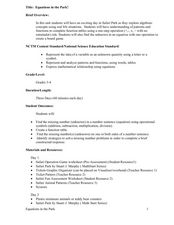Curated OER
Balancing Equations Can Be Fun!
Learners participate in an online activity in order to master balancing equations before applying the concept to chemistry activities.
PhET
Balancing Chemical Equations
Just like the old saying goes, "What goes in must come out." This simulation allows pupils to balance chemical equations. The introduction gives three examples before scholars switch to game mode, pick their level, and continue to...
Curated OER
Learning how to balance equations
High schoolers play Chembalancer game and balance equations using the trial and error method.
Curated OER
Balancing Number Sentences to Introduce Missing Values
Students balance number sentences to learn about missing values. In this balanced equations instructional activity, students use the word problem to study missing values. Students watch a video about the topic and play two games about...
Curated OER
Balancing Equations
Students balance equations using the correct method. In this algebra lesson, students solve linear equations using a virtual balance beam as a manipulative. They play games to reinforce the concept of equations being and staying balanced.
National Security Agency
Equations and Expressions
Learners demonstrate their knowledge pictorially, concretely, and abstractly in this unit meant to last three hours over three days. Using hands-on activities, manipulatives, real-world applications, and problem solving, learners write...
Curated OER
Equations in the Park
Students explore algebraic concepts using real life situations. In this equations lesson, students develop strategies to solve missing number problems. Students participate in a board game based on algebraic equations.
National Security Agency
A Balancing Act: Solving Multi-Step Equations
Wow! Put on that thinking cap and solve multi-step equations. To solve equations, learners review the use of the distributive property and combining like terms. This three-day activity comes with about 20 pages of worksheets, warm-ups,...
Curated OER
Interesting Integers and Exciting Equations
An 80-page resource provides four lessons and all associated worksheets to teach middle schoolers about expressions and equations. The lessons are hands-on, using games, "integer chips," a balance and cubes, and cut and paste activities....
Utah Education Network (UEN)
Solving Single-Variable Equations Part II
Brainiacs explore the concept of solving single-variable equations.They use inverse operations to solve equations, and participate in activities such as balancing an equation scale. This is an awesome lesson plan, complete with game...
Curated OER
Figuring Out Equations With Figurines
Students inspect solving equations with one variable. Through the use of a scale balance, they examine the importance of equality in an equation. By playing a balance game with figurines and a scale, students discover methods of...
Curated OER
Balancing Discoveries
Students use a balance to help them with their addition facts. In this addition lesson plan, students also play the seven up game to memorize their facts.
Curated OER
Center Time
First graders recognize and represent mathematical relationships using symbols and use number sentences with operational symbols to solve problems. They complete various activities such as tug of war, monkeys on a vine, and hit and miss....
Pennsylvania Department of Education
Links Away: Looking Back and Moving Forward
Pupils explore fact families. In this math lesson, students use links to model a fact family. Pupils solve addition and subtraction problems.















